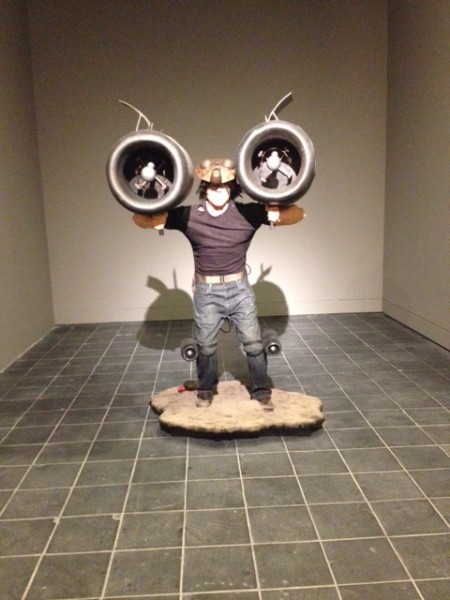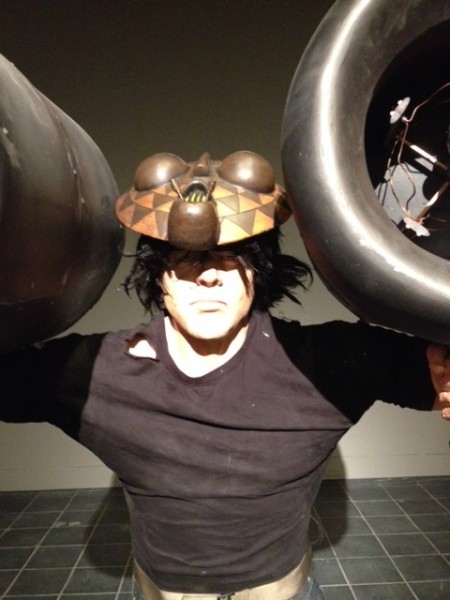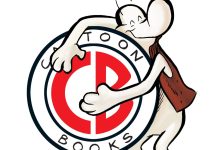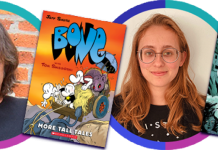by Christian Hoffer
As part of the Columbus College of Arts and Design’s MIX Comic Symposium, Tom Spurgeon (of Comics Reporter fame) interviewed Jeff Smith at the college’s Canzani Center Friday evening. Smith was the keynote guest of the two day academic symposium, which featured a variety of panels, workshops and presentations about the art form, and had participated in a panel about alternative comics earlier that day. Spurgeon had also participated in a panel discussing the growing Columbus comic scene moderated by local creator James Moore.
The event was attended by a standing only room crowd of about 400 art students, local creators and fans of Smith’s work. For two hours, Smith discussed his past works, including Bone, RASL and Captain Marvel and the Monster Society of Evil, the challenges of self-publishing, and his upcoming Tuki Saves the Humans webcomic, before taking a few questions and signing books.
Spurgeon opened the interview by asking about Smith’s ties to Columbus, and how the community influenced his work. Smith discussed how the rolling Appalachian foothills outside of Columbus was his favorite type of landscape to draw, and how Old Man’s Cave from Bone is actually located at Hocking Hills, a state park located outside of Columbus. When visiting the cave as a child, Smith’s imagination would run wild, and he pictured a Tolkienesque fantasy unfolding at the cave.
Smith discussed his early influences in comics, how he used to read comic strips like Peanuts and Uncle Scrooge as a child, and how his father used to read Mad Magazine to him as a kid. Mad Magazine was influential in helping Smith understand the pop culture landscape in the 1960s, which was filled with bad television and even worse commercials.
Smith credited his wife, Vijaya Iyer, for supporting and encouraging him while researching and working on Bone. When asked about his decision to self-publish Bone instead of pursuing more traditional outlets, Smith discussed his frustration with the newspaper comic syndicates. He recounted an incident in which an editor asked Smith to have his characters talk in thought balloons instead of word balloons, because “Garfield talks in word balloons.” That spurred him towards self-publishing, as he didn’t want to ask for permission to write the story he wanted to write. Of course, Smith mused, he still needed to ask for his wife’s permission. He also mentioned that Mark Askwith, the developer of the Canadian magazine show Prisoners of Galaxy, was the first person to reach out to him as a fan of Bone, and sent him a video tape of Neil Gaiman praising the series on a recent episode of the show, which blew him and his wife away.
Spurgeon and Smith also discussed the subversion of traditional fantasy tropes in Bone and Smith’s use of story beats and strong characterization to advance his story. Spurgeon added that he thought that Smith was underrated as a scriptwriter and as a designer, and pointed out several examples from both Bone and RASL on how Smith excels with dialogue and panel design. In particular, Smith stressed that logo design is critical, and pointed out how Bone’s logo was designed so that the logo would stand out even if the rest of the cover was obscured.
The conversation ended with a discussion on Tuki Saves the Humans and Smith’s exploration of webcomics and digital publishing. Smith mentioned Kate Beaton’s Hark a Vagrant, Zac Gorman’s Magical Game Time and Sam Alden’s Haunter as webcomics he was currently following. He stated that he was intrigued by digital publishing and added that the world was moving towards digital distribution and publishing. With Tuki Saves the Humans, Smith hoped that he could find a distribution model that could help other cartoonists make money off their webcomics, and pointed out how First Second Publishing handled Faith Erin Hicks’ webcomics as a potential model to follow. He also added that he still planned to collect and publish the Tuki Saves the Human eventually, and that he saw computers as a way to facilitate art, not to create it. While both coloring and lettering are done digitally, Smith still draws and inks his comics by hand.
Smith finished by thanking students Christopher Castorano and Tyler Crooks for building a lifesize sculpture of RASL, complete with mask, dimension hopping engines and a discarded bottle of Maker’s Mark. The sculpture accompanied an exhibit of original artwork from RASL. After the keynote ended, Smith stayed to sign books, including the recently released RASL color hardcover, for a lengthy line of fans and admirers.










I believe the Garfield story above should say “Garfield talks in thought bubbles,” not “Garfield talks in word balloons.”
I say this because: 1) Garfield talks in thought bubbles, and 2) as written, the story doesn’t really make sense.
Good work, Hoffer. I got to talk to Jeff at SDCC 2013 for the first time and he’s just a brilliant mind. Rasil is based where I’m from and he nailed Tucson to the every saguaro and major landmark. Best panel at that con was Remembering WIll Eisner with Dennis Kitchen, Neil Gaiman, Paul Levitz Jeff Smith, and Scott McCould. I hope someone recorded that panel because it was mind blowing.
This article feels like it’s missing an introductory paragraph that explains the fact that Tom Spurgeon was talking to Jeff Smith. As it is, Spurgeon just shows up in the second paragraph without a first name.
RASL…Romance At the Speed of Light. Not Rasil.
“Mad Magazine was influential in helping Smith understand the pop culture landscape in the 1960s, which was filled with bad television and even worse commercials.”
Hmmm … television was also filled with great shows and commercials. We need a direct quote here, and someone asking him to elaborate.
Everyone, here’s the video of the keynote, which was posted by CCAD last Friday.
http://www.youtube.com/watch?v=Sdkr2SBh-UI&list=PLqOcJnZWQFKJyM-V7Kx4RILzcuqovHolk&index=8&noredirect=1
Why read the summary when you can get the real thing?
Thanks, boner :)
Rlly good one
Comments are closed.